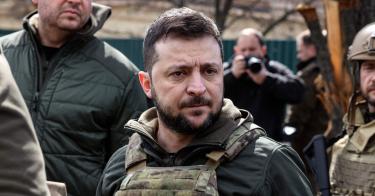Shortly before Russian President Vladimir Putin launched his latest invasion of Ukraine, the Chairman of the Joint Chiefs of Staff, Gen. Mark Milley, reportedly told congressional leaders meeting in closed session that the smaller country would "fall in 72 hours." Welp, here we are, well over a month into that three-day war.
So how did the principal military advisor to the president of the United States get it so wrong?
Perhaps, Milley forgot the most important military adage of all: "No plan survives contact with the enemy."
Give the Pentagon its due. U.S. military analysts correctly anticipated the broad strokes of Putin’s initial battle plan: strike from the north to decapitate the government in Kiev, while launching a sweeping multi-prong attack from the south and the east. The Kremlin’s expectation was that when Ukrainians found themselves leaderless and overmatched, the country’s armed forces and its people would not put up much of a fight. After that, it would be merely a matter of occupation and annexation.
Looking at the volume and disposition of Russian forces arrayed on Ukraine’s borders many analysts—not just those at the Pentagon—agreed that a swift Russian victory was certainly possible… if Putin decided to pull the trigger.
And, if everything had gone right for Putin, people today might be toasting Milley as a military Nostradamus. But, as if often the case in war, once the shooting starts the dogs of war scatter in all kinds of unpredictable ways. A reasonable issue to raise is: Why didn’t Milley better prepare us for that?
The best military advice is not a simple prediction of what will happen; it’s a matter of preparing to respond to the terrible turns—and take advantage of the spectacular opportunities—that were not predicted. Milley’s misjudgment raises two serious concerns.
First, where were the comprehensive assessments of Russian military capabilities? In the 1980s, the Pentagon’s Office of Net Assessment under the legendary leadership of Andrew Marshall pioneered an analysis of enemy forces that looked at all the factors that affect combat power--everything from the state of training and supplies to the quality of equipment. This yielded a far more sophisticated analysis than the simplistic "correlation of forces" comparisons that counted how many tanks, planes, and troops each side had.
Where is that quality of analysis now? With the benefit of hindsight, we know that part of Putin’s problem is that the Ukrainians didn’t follow his plan and collapse like they were supposed to. But we now have lots of evidence that the Russian military itself is riddled with shortcomings, from inadequate training to poor leadership, corruption, and significant shortfalls in some critical capabilities—particularly secure communications and real-time intelligence, surveillance, and targeting.
How deep were U.S. military assessments beyond looking at Putin’s plans? How much was shared with the White House or Congress or the allies or Ukraine?
Beyond that, how much did the Pentagon explore the real serious stuff of military analysis and planning: what happens when what is most expected doesn’t happen? Did they prepare the contingency plans for a variety of possible scenarios?
From all appearances, there was little impulse to do that before the conflict. When war did break out, there seemed a reluctance to do much because the outcome was foretold. Then, as the battle lengthened, the administration proved reluctant to do more to aid Ukraine out of fear Putin would see that as escalatory.
Only once it was clear Putin wasn’t winning on the battlefield, did the Pentagon acknowledge that this could be a long-protracted war, and only then did they lean forward into wanting to do more. This sure looks reacting to the course of events rather thinking ahead on how to make the most of them.
Our military seems to have lost some of the skills that have made us so formidable.
>>> What the U.S. Must Do Immediately to Support Ukraine
This pathology isn’t new. It reminds exactly of when the U.S. went into the Iraq War, was surprised by the turmoil that followed, and found itself lodged in a long, tough and messy fight to catch up.
Here is the problem. The U.S. military is famous for learning from mistakes and doing better next time. That is not happening. How far have we come since Iraq? We fumbled the ball in the Afghanistan withdrawal. Now, we’re struggling to keep up again. What happens next time, when it’s Taiwan being invaded by China or some other crisis?
Here is what’s different. Over the Obama years, we have a grown a different generation of senior of military officers who seem less prepared to deal with the hard realities of real wars and real military missions. This is not to question their patriotism or their professionalism. There is a question, however, as to whether they are up to the challenge of managing civil-military relations effectively, in advising and supporting a Congress and a president on how best to protect America’s interests.
Both Afghanistan and Ukraine have shown we have a weak commander-in-chief. Do we have weak senior military leaders to match?
This piece originally appeared in Fox News




